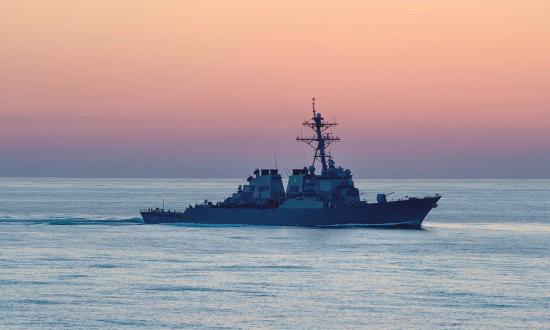Russia’s war in Ukraine offers a critical case study on why—and how—to build a more robust kill chain that leverages partners’ and allies’ capabilities. A more expansive satellite communications (SATCOM) network that enables a real-time integrated common operational picture (COP) will be necessary to generate the relative combat power advantage over the People’s Liberation Army (PLA). Russia initiated combat operations in Ukraine with cyberattacks on SATCOM to disrupt Ukraine’s kill chain—the methodology for finding, fixing, targeting, tracking, engaging, and assessing (F2T2EA) an adversarial objective. The United States, alongside partners, allies, and industry, was able to blunt Russia’s invasion by reconstructing Ukraine’s SATCOM network and sharing critical intelligence. However, the kill chain architecture leveraged against Russia does not exist in the first island chain of the western Pacific.
The 2022 National Defense Strategy identified China as “the most comprehensive and serious challenge to U.S. national security,” with integrated deterrence as the primary means for responding. It also stated that “greater intelligence and information sharing, and combined planning for shared deterrence challenges” are vital to effectively implement the strategy for integrated deterrence. To achieve the capability required to deter the PLA, the Department of Defense (DOD) must further develop SATCOM architecture in the first island chain and expand partners and allies’ access to the COP to build a coalition kill chain that can mass fires.
Expand SATCOM and the COP
As the battlefield becomes more expansive across domains, it will inherently become more dependent on SATCOM to enable combatants to close kill chains. A valuable lesson observed from Russia’s invasion is that the joint force can enhance its kill chain by proliferating and diversifying SATCOM infrastructure and expanding access to intelligence. To do this, the United States had to create more permissive policy for intelligence sharing for more effective targeting. Furthermore, kill chains in the Pacific are more dependent on SATCOM as submarine internet cables are more vulnerable and likely already compromised by China.
Leading up to the Ukraine invasion, Russia disabled tens of thousands of military and civilian SATCOM terminals. Both military and civilian broadband Internet was severely degraded. In an anticipated zero-day cyberattack, the degraded SATCOM rendered Ukraine’s long-range artillery counterattack “ineffective.” In one instance, Enercon, a German energy producer, reported that 5,800 of its wind turbines were knocked offline as civilian broadband Internet service in the region was attacked. The United States and Europe were forced to rapidly revert to commercial-off-the-shelf broadband services provided by SpaceX’s Starlink to reestablish civilian and military SATCOM. Remarkably, Starlink also enabled Ukraine to better mask its electronic signature, as SATCOM wavelengths are more difficult to detect compared to those propagated via ground. Based off these lessons, there are two measures the United States could take to create a better kill chain network in the first island chain.
First, to enhance U.S. SATCOM architecture, the DoD could begin to supplement geosynchronous orbit satellites by proliferating low-earth-orbit and medium-earth-orbit satellites. This would reduce vulnerabilities related to adversarial space operations and expand SATCOM range and resiliency. SpaceX’s Starlink functions off the same principle of a mesh networks of low-earth-orbit satellites.
Second, the United States could use partner and allies’ satellite networks and make policy more permissive with intelligence sharing. In March 2022, the Department of Defense announced its Joint All-Domain Command and Control Implementation Plan with the 5th line of effort to “Modernize Mission Partner Information Sharing.” The intent is to enhance the ability to integrate partner and allies’ data for all-domain coalition operations. After all, the value in integrating systems is only as good as the real-time tracks being shared. To build a coalition kill chain, U.S. policy will have to become more permissive with intelligence sharing among partners and allies.
Structure of the Multinational Kill Chain
The United States will also need to create a methodology for building a multinational COP and integrated fires network. Tactical-level forces across the partner and ally network must evolve to contribute more to operational and strategic-level fires and effects. This effort is twofold: first, the joint force could expand partners and allies’ access to Type-1 Link-16 cryptography, so they are built into the operational tasking link; and second, it could reduce constraints on protocols and pathways for sharing information.
The first effort would integrate partners and allies into the tactical data link router used by the U.S. joint force, also known as the Joint Range Extension Applications Protocol. This would require access to the joint Link 16 architecture by assigning partners and allies a cryptographic variable logic label via an operational tasking data link (OPTASK LINK). Access to the Link 16 architecture would provide a shared COP capable of integrating national technical means for finding and fixing targets and cuing assets to track them. Target quality and the probability of successful strike are positively correlated with the number of assets that sense, track, and pass data in the OPTASK LINK architecture. For instance, the Naval Integrated Fires Element (NIFE) serves as a 24/7 watch center to process signals of immediate use to military consumers worldwide. In the proposed system, allies and partners included in the same OPTASKLINK will see the same tracks facilitated and provided by elements like the NIFE.1
After expanding SATCOM and access to a multinational COP, the United States could reduce policy barriers to expand the integrated fires network to partners and allies. There is historical precedence for this. In 1943, several months prior to the successful landing of U.S. and UK troops in Sicily during World War II, the two allies signed the British-United States Agreement (BRUSA), a constitution to “exchange completely all information concerning the detection, identification and interception of signal from, and the solution of codes and cyphers, used by the Military and Air Forces of the Axis power, including secret services.” The pact formed the foundation for what evolved into today’s Five Eyes partnership between the United States, United Kingdom, Australia, Canada, and New Zealand.
Given the possibility of a large-scale Chinese offensive within the coming years, it is time for the joint force to increase information sharing and trust building with partners and allies to enhance awareness of the battle space in the first island chain. This would not only enhance F2T2EA but could also enhance regional awareness of China’s malign actions. That awareness would reinforce an international coalition. In response to China’s aggressive acts in the South China Sea, then–Secretary of State Michael R. Pompeo stated in 2020 that:
The world will not allow Beijing to treat the South China Sea as its maritime empire. America stands with our Southeast Asian allies and partners in protecting their sovereign rights to offshore resources, consistent with their rights and obligations under international law. We stand with the international community in defense of freedom of the seas and respect for sovereignty and reject any push to impose “might makes right” in the South China Sea or the wider region.
More real-time information and intelligence sharing with partners and allies in the Pacific is required to achieve “defense of freedom of the seas and respect for sovereignty.” China is building a navy that now has more ships than the U.S. Navy, with an estimated 400 ships. “Between 2015 and 2017, Chinese shipyards launched twice as many tons worth of naval vessels as their U.S. counterparts.”2 In response, there are changes the joint force can implement today to respond to China’s growing combat power.
As the joint force continues to develop long-range ship interdiction capabilities, it can tap into capabilities already developed by allies and partners through increased information sharing, collaboration on fires planning and executing, and bilateral and multilateral rehearsals. The Japan Self-Defense Forces have a robust inventory of large and medium-scale ballistic missile capabilities with the SM-3 interceptor, the PAC-3 air defense missile, and the Type 12 ship interdiction missile that will eventually extend out to 1,500 kilometers in range. Taiwan’s Navy maintains the supersonic antiship cruise missiles Hsiung Feng II and III in its inventory, which have ranges of more than 150 kilometers. The Philippine Navy will acquire the Indian made supersonic BrahMos antiship missile by 2023. Given current trajectories for China’s naval and ground-based fires assets, the United States will not be able to unilaterally match China’s relative combat power in the Pacific. Thus, the U.S. strategy must prioritize a multilateral kill chain.
Once the multilateral kill chain is built, it must be rehearsed with common understanding of joint war-at-sea terminology among partners and allies. War-at-sea, zones of action, and zones of fire must be standardized in planning to achieve a common lexicon. The Global Area Reference System is also key to orientation and understanding the battlespace. Rehearsing multilateral plans for fire, specifically including protocols for authorities, and collaborating on battle damage assessments are necessary to achieve true integration.
Looking Forward
By building the SATCOM and COP architecture with partners and allies, the United States and partners and allies can achieve relative combat power advantage over the PLA. Trust is the coin of the realm, and the value associated with creating a more robust kill chain outweighs its risks. The two most recent iterations of the U.S. National Defense Strategy stressed the importance of allies and partners to deterring and defending against China’s expansionism. Creating an integrated coalition, however, requires more than diplomacy. True military power will come from sharing tactical intelligence and integrating allies and partners into the link architecture.
1. Space Development Agency, “Attachment 1—Performance Work Statement for SDA Tranche 0: Mission Systems Engineering and Integration,” Space Development Agency Tranche 0 Mission Systems Engineering and Integration (6 July 2020), 5.
2. Christian Brose, The Kill Chain: Defending America in the Future of High-Tech Warfare (New York, NY: Hachette Books, 2020), 93.






